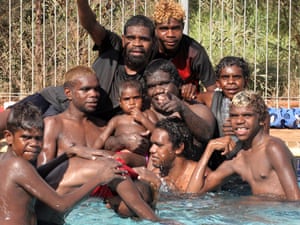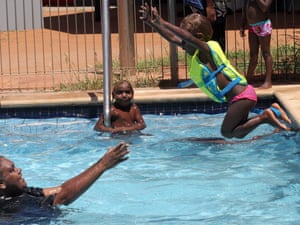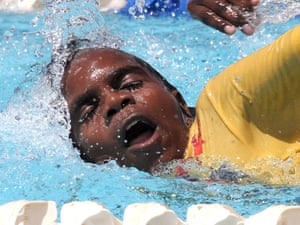Pools in the desert: why Indigenous communities need space to swim | Philippa Nicole Barr and Melanie Garrick
Most remote Indigenous communities are a long way from cities, easy to ignore and easier to misunderstand. Projects intended to improve living standards in these places are too often abandoned due to lack of money, poor planning and impatience. Change takes time, in many cases longer than a single term of government.
There is a growing body of evidence that a swimming pool in remote communities greatly improves not only the health and fitness of young people, but also their interest in school and other activities. Pools solve many problems at once. In the central desert, the swimming pool is crucial to the health and social life of the community.

In searing heat, pools provide the only way you can cool off and get fit at the same time. They do so in a clean, controlled environment. While kids will dunk themselves in any available water, it seems wrong to deny them the opportunity to do so in a way which is proven to improve eye health, encourage them to get an education, and provide a new site for community organisation.
According to associate professor Deborah Lehmann, from WA’s Telethon Institute, “given their unacceptably high rates of infectious diseases, chronic diseases and drowning, the Aboriginal and Torres Strait Islander population would benefit more than any other group in Australia from having access to swimming pools”.
The benefits also extend to education. A “no school, no pool” policy, to limit pool entry to students who go to school, played a key part in improving attendance rates at Areyonga, Santa Teresa and Yuendumu. This policy was the rationale for the development of the 2005 pools in remote areas scheme, which had a budget of $4.55m to build pools in some of the most isolated communities in Australia. Now pools face closure, at the same time as communities are becoming targets of a $28m anti-truancy intervention.

Pools are built in part with government money, but there is no long term plan for how they will be maintained or filled from year to year. They are thus funded or closed from season to season depending on the generosity of surrounding mines, the success of local art centres, and the sympathy of wealthy patrons. To fund her local pool, Susie Low, the CEO of Yuendumu’s Warlpiri youth development Aboriginal corporation “relied on $49,000 from NT sport and recreation, a private donation of $50,000, and $15,000 from Facebook friends”.
The pools at Kintore and Santa Teresa reopened this year thanks to emergency federal government funding. Scullion admitted the pools were a drawcard to boost school attendance, justifying a “one-off payment to support remote community pools to be open for the 2013-2014 season”. Yet he has not committed to funding for next Summer.
In 2010, 18 remote pools did not have enough funding to pay staff or maintenance costs. “It’s easy to get funding to build a pool,” said Floss Roberts from the NT royal life saving society, “the real issue is ongoing operational funding”.

Of the 18 pools in remote communities, seven were built over 20 years ago and five over 35 years ago. “These pools were built in a different era,” said Jeff McLeod, CEO of Central Australia’s MacDonnell shire council. “When the pools were built we didn’t employ lifeguards, energy and water costs have increased, and now there are strict water management regulations and OH&S requirements.”
Cathryn Hutton, the CEO of the Central Desert regional council, said that “in many cases you end up with very degraded facilities because nobody has the money to look after them once they are put into the ground.”
Swimming pools are a worthwhile investment, but instead of maximising their value, the current funding model diminishes it. Ultimately, a single level of government must take responsibility. With its current drive to reform school attendance, the obvious choice is the federal government.

“It’s very positive, it provides all sorts of opportunities and I cannot understand why between the three levels of government they cannot find the money to fund a pool in a community where that’s about all that there is,” said NT school principal Daniel Hollamby.
Long-term planning and maintenance of this infrastructure is a better strategy than one year of pool, two years of truancy officers, and another few years of nothing while government works out what to do next. To build trust and move forward merits the same committed and sustainable approach as was practiced in the NT for so many years.
Source: Read Full Article


